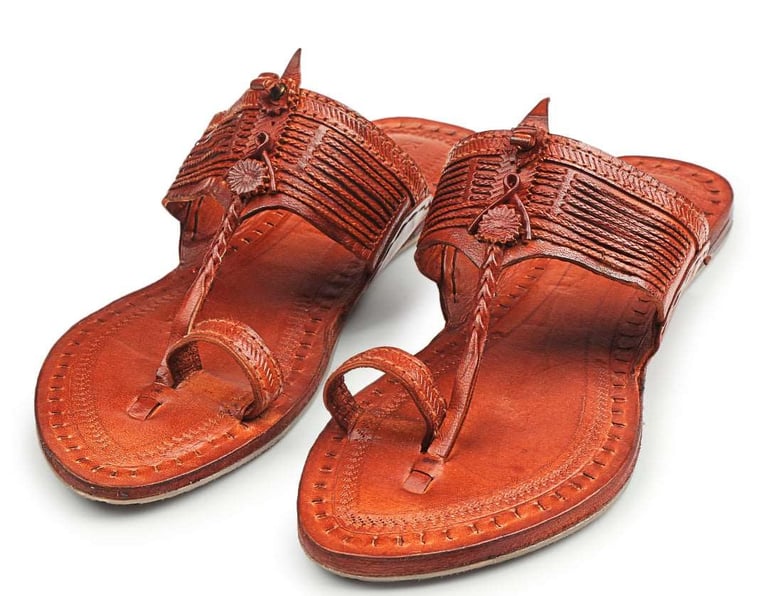Prada Acknowledges Kolhapuri Chappal Inspiration: A Cultural Turning Point or Just a PR Move?
Blog post description.
7/11/20253 min read


In a world where fashion constantly feeds off culture, a recent global scandal has put the spotlight on something far more enduring than a seasonal trend: craft ethics. The now-infamous Prada Kolhapuri Chappal controversy has not only sparked conversation—but possibly, sparked change.
After weeks of backlash and headlines like "Cultural Appropriation or Appreciation?", Italian luxury fashion house Prada has officially acknowledged its inspiration from India’s traditional Kolhapuri chappals—a centuries-old artisanal footwear, handcrafted by communities in Maharashtra and Karnataka.
But while that admission seems like a resolution, deeper questions remain: Is acknowledgment enough? What’s next for the artisans who make this cultural heritage come alive every day?
What Sparked the Prada-Kolhapuri Chappal Controversy?
At the Spring/Summer 2026 Milan Fashion Week, Prada showcased a sandal design that bore an uncanny resemblance to Kolhapuri chappals—flat, leather, hand-stitched sandals rooted in over 800 years of Indian tradition. The shoes were paraded without a single mention of their South Asian roots.
The fallout was immediate!
Social media exploded under the hashtag #PradaKolhapuriControversy, with many calling it a blatant act of cultural appropriation. From fashion watchdogs to artisan clusters in Maharashtra, the global fashion house was accused of profiting off a cultural symbol without offering credit or compensation.
The situation brought long-standing industry issues into the limelight: unacknowledged inspiration, ethical blind spots, and global power imbalances between luxury fashion and traditional artisans.
The Artisan Voices Behind the Craft
As per the Hindu article, for many artisans like Sadashiv Sanake and Sunita Satpute, who spend over eight hours crafting just 8–10 pairs of chappals a day—often earning less than ₹400—it was both shocking and surreal.
“When I heard those sandals might sell for over ₹1 lakh abroad, I asked—do they have gold in them?” said Mr. Sanake in a BBC interview.
Artisans, especially from the Charmakar (Dalit) community, have passed down the skill for generations, often battling systemic caste discrimination, poor pay, and a lack of visibility. Most of them have no access to global markets, let alone protection under international design laws.
Prada's Response to Backlash
Under pressure, Prada issued a formal letter to the Maharashtra Chamber of Commerce, Industry & Agriculture (MACCIA) acknowledging the cultural significance of Indian craftsmanship. The company stated: "We deeply recognise the cultural significance of such Indian craftsmanship… We are committed to responsible design practices and fostering cultural engagement."
While Prada claims the sandals were still in “early design development” and not commercialized, MACCIA President Lalit Gandhi confirmed that the brand is now open to exploring "collaboration" with artisan clusters. Meetings are scheduled, and a patent process is underway to globally safeguard the design of Kolhapuri chappals.
In addition, MACCIA has demanded Public acknowledgment (now received), Fair compensation or revenue-sharing for artisans, and Long-term support for ethical fashion practices and cultural IP rights.
What the Artisans Really Want
The artisans have made one thing clear: they want opportunity, not charity!
Shivaraj Soudagar, who runs the Athani Kolhapuri cluster, put it best: "Everyone is blaming Prada, but they’ve made our chappals global. What we need now is better design training, global exposure, and fair pay—not pity." He highlighted that a Kolhapuri artisan earns ₹250–400 per pair, while middlemen, retailers, and now global brands walk away with the majority of the profit.
From Controversy to Cultural Correction?
This isn’t the first time Indian crafts have been co-opted without credit; Chikankari, Ikat, mirror work, block prints, and even Ajrakh motifs have all shown up on international runways without artisan attribution.
But what makes this moment different is the scale of the response. Legal discussions. Cultural backlash. International media coverage. Perhaps even policy-level impact.
MACCIA’s plan to patent Kolhapuri chappals, and their plea for the Indian government to escalate the issue via the TRIPS agreement at the World Trade Organization, signal a serious step toward protecting India’s intangible heritage.
Let This Be a Wake-Up Call
The Prada Kolhapuri controversy is not just a case study in appropriation—it’s a call to action.
For global fashion houses, it’s a reminder: credit is currency. For the Indian government, it’s a moment to rise—to not just celebrate crafts but also shield them. And for us as consumers, it’s time to ask: what are we really paying for—design, or dignity?
Fashion doesn't exist in a vacuum—it’s built on stories, communities, and centuries of tradition. When those roots are ignored, fashion becomes exploitation. When they’re honoured, it becomes culture.
If luxury brands want the world to walk in their shoes, maybe it’s time they walked a mile in an artisan’s too.


